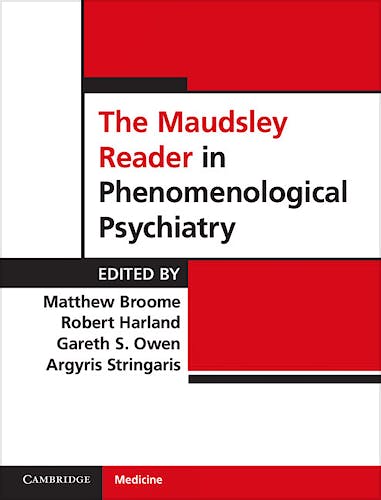

No hay productos en el carrito



The Maudsley Reader in Phenomenological Psychiatry
Broome, M. — Harland, R. — Owen, G. — Stringaris, A.
1ª Edición Febrero 2013
Inglés
Tapa dura
320 pags
500 gr
19 x 25 x null cm
ISBN 9780521882750
Editorial CAMBRIDGE
LIBRO IMPRESO
-5%
147,24 €139,88 €IVA incluido
141,58 €134,50 €IVA no incluido
Recíbelo en un plazo de
2 - 3 semanas
Description
The interaction between philosophy and clinical psychopathology in the form of the 'phenomenological movement' was one of the most significant events to occur in mental health over the course of the last century. As the gulf between 'analytical' and 'continential' philosophy reduces, and as clinical psychiatry looks beyond DSM-IV and ICD-10, there is renewed enthusiasm for phenomenological thinking. This unique book brings together and interprets previously hard to find texts, new translations and passages detailing the interplay between philosophy and psychopathology, making them accessible to a new generation of mental health researchers, practitioners and policy makers. The content charts both the influence of key philosophers on ways of thinking and describes the impact and influence of phenomenological approaches to clinical work and understanding in a variety of mental disorders.
Features
- Presents a unique collection of key philosophical texts for non-philosophers summarizing phenomenological methodology in philosophy
- Brings together hard-to-find primary sources in psychiatry and includes new translations prepared specifically for this volume
- Includes brief and clear commentaries linking readings and putting them into context
Reviews
Advance praise:'It brings together texts from both philosophers and clinicians
which are otherwise difficult to access; many are newly translated. The editors
have done excellent work … absorbing and illuminating.'
Lady Mary Warnock
Table of Contents
Prologue
How to read this book
Acknowledgements
Part I. Intellectual Background:
1. Introduction
Section 1. Influences on Phenomenology: 2. Franz Brentano (1838–1917):
Brentano, F. (1887), 'The Concept of a Descriptive Psychology'
Brentano, F. (1874), 'The Distinction between Mental and Physical Phenomena'
3. Wilhelm Dilthey (1833–1911): Dilthey, W. (1894), 'Ideas about a Descriptive
and Analytical Psychology'
4. Max Weber (1864–1920): Weber, M. (1949), 'Objectivity' in Social Science
and Social Policy'
5. Henri Bergson (1859–1941): Bergson, H. (1910), Selections from 'Time
and Free Will: An Essay on the Immediate Data of Consciousness'
Section 2. Phenomenological Philosophy: 6. Edmund Husserl (1859–1938):
Husserl, E. (1919), 'Ideas 1'
Husserl, E. (1948), Selections from 'Experience and Judgment'
7. Max Scheler (1874–1928): Scheler, M. (1913–14) 'Phenomenology
and the Theory of Cognition'
Scheler, M. (1928), Selections from 'Man's Place in Nature'
Scheler, M. (1913–16), 'Feeling and Feeling States'
Scheler, M. (1922), Selections from 'The Nature of Sympathy'
Scheler, M. (1914), 'On the Idea of Man'
Scheler, M. (1928), Selections from 'The Human Place in the Cosmos'
8. Martin Heidegger (1889–1976): Heidegger, M. (1919), 'The Idea of Philosophy
and the Problem of Worldview,' War Emergency Semester
Heidegger, M. (1994), Selections from 'Introduction to Phenomenological Research'
Heidegger, M. (1927), 'The Worldhood of the World'
Heidegger, M. (1927), 'Fear as a Mode of State-of-Mind'
Part II. The Phenomenological Approach in Psychiatry:
9. Introduction
10. Jaspers' approach 1: static understanding – 'phenomenology': Jaspers,
K. (1912), 'The Phenomenological Approach in Psychopathology'
11. Jaspers' approach 2: genetic understanding – 'Verstehen': Jaspers,
K. (1959), 'Meaningful psychic connections'
12. Minkowski's structural approach: Minkowski, E. (1933), 'The Notion of a
Generating Disorder and the Structural Analysis of Mental Disorders'
13. Binswanger's existential approach: Binswanger, L. (1946), 'The Existential
Analysis School of Thought'
Part III. Phenomenologies of Mental Disorder:
14. Introduction
15. Brain injury: Goldstein, K. (1940), 'Pathology and the Nature of Man: The
Abstract Attitude in Patients with Lesions of the Brain Cortex'
16. Schizophrenia: Jaspers, K. (1959), 'The Worlds of Schizophrenic Patients'
Minkowski, E. (1927), 'The Essential Disorder Underlying Schizophrenia and Schizophrenic
Thought'
Binswanger, L. (1956), 'Extravagance, Perverseness, Manneristic Behaviour and
Schizophrenia'
Blankenburg, W. (1968), 'First Steps Toward a Psychopathology of 'Common Sense''
Blankenburg, W. (1965), 'On the Differential Phenomenology of Delusional Perception:
A Study of an Abnormal Significant Experience'
Conrad, K. (1958), 'Beginning Schizophrenia: Attempt for a Gestalt-Analysis
of Delusion'
Rümke, H. (1948), 'The Nuclear Symptom of Schizophrenia and the Praecox
Feeling'
17. Affective disorder: Binswanger, L. (1964), 'On the Manic Mode of Being-in-the-World'
Schneider, K. (1920), 'The Stratification of Emotional Life and the Structure
of States of Depression'
Straus, E. (1928), 'The Experience of Time in Endogenous Depression and in the
Psychopathic Depressive State'
von Gebstattel, V. (1928), 'Compulsive Thought Relating to Time in Melancholia'
Tellenbach, H. (1982), 'Melancholy as Endocosmogenic Psychosis'
18. Obsessive compulsive disorder: Straus, E. (1938), 'The Pathology of Compulsion'
von Gebsattel, V. (1938), 'The World of the Compulsive'
19. Other: Scheler, M. (1913), 'The Psychology of So-called Compensation Hysteria
and the Real Battle against Illness'
von Gebsattel, V. (1963), 'The Meaning of Medical Practice'
Merleau-Ponty, M. (1945), 'Cézanne's Doubt'
Epilogue
Index.
© 2025 Axón Librería S.L.
2.149.0